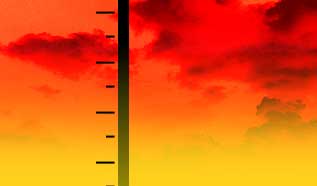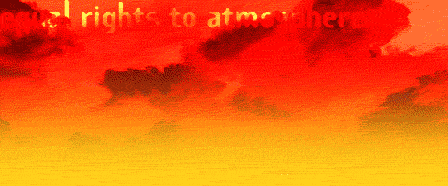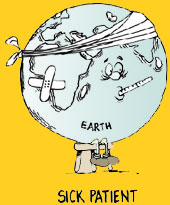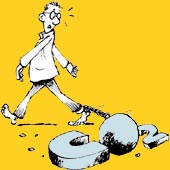
|
 |
 |
| |
|
 Earth has a fever Earth has a feverThere naturally exist in the atmosphere gases such as carbon dioxide (CO2), methane (Ch4), nitrous oxide (N2O), chlorofluorocarbons (CFCs), and water vapour. They are called greenhouse gases. That’s because they act like a blanket spread over the earth’s surface, helping to keep it warm. The temperatures experienced near the earth’s surface, and therefore its climate, depend upon a balance. Waves of radiant energy hit the earth’s surface, one-third of which is reflected while the rest is absorbed by the atmosphere, ocean, land, and biota (forests, wetlands). As reflected waves of radiant energy travel through the atmosphere, they are ‘caught’ by the greenhouse gases and re-reflected back. If there had been no greenhouse gases, the earth’s surface temperature would have been 33°C lower. Earth would have been uninhabitable. Scientists get AlarmedBut now human activities are changing this balance. Since the industrial revolution, as research has found, the concentrations of these gases in the atmosphere — especially carbon dioxide — have been increasing. This is called the enhanced greenhouse effect. The blanket has become thicker, to the point that today, the global climate system is getting stressed out. The global climate system consists of complex flows of energy and chemical reactions within and between atmosphere, land, ocean and biota. As one element (the radiant energy balance) goes out of gear, so the flows get affected. The climate system begins to change.
It was in mid-late 1980s that scientists from all over the world began to raise the alarm about global warming, and climate change. The world’s nations began to notice. The United Nations began to create institutions to look into the reality of this global phenomenon. By 1990, it was clear that something had to be done. Here was a global environmental problem. It required a solution that involved — and had the approval of — the whole world. A legally-binding international treaty on the world’s climate. Negotiations begin... The purpose of these negotiations was to review and restrict all those human activities that could transform the climate. ...in an unequal world Carbon die-oxide  Primarily,
it is carbon dioxide (CO2) that heats up the Earth’s atmosphere and so causes climate
change. Therefore, if action has to be taken before atmospheric processes that endanger
human civilisation set into motion, then the world has to reduce its CO2 emissions. Primarily,
it is carbon dioxide (CO2) that heats up the Earth’s atmosphere and so causes climate
change. Therefore, if action has to be taken before atmospheric processes that endanger
human civilisation set into motion, then the world has to reduce its CO2 emissions.
But CO2 is produced largely through the burning of fossil fuels: coal, oil, and gas. In steel and toy factories. In power plants. Cars and jeeps. Reducing CO2 emissions means seriously tinkering with the way we now produce things. It requires serious transformation in industrial and agricultural production, power generation, transportation systems, household energy consumption, even forest management — literally all the elements of the modern economy. Is completely politicalFirst, there are the developed nations of the world: the North, the G-8. They owe their current prosperity to years of fossil fuel burning. Slowly polluting the atmosphere to fever pitch. Even now, they are high-emission nations. Then, there are the developing nations of the world: the South, the G-77 and China. Just got on to a growth path. Or, just getting on or trying to get on. Even now, they are low-emission nations. Both groups of nations face the fact that limiting emissions means limiting growth. And that the climate change problem has to be resolved. Tug-of-warIndustrialised nations: not so vulnerable to climate change; unwilling to water down their lifestyle; resistant to taking on the expenses of shifting to a low-carbon economy; ready to exploit a world order where the gears of power move at the bidding of those who possess the moolah. Industrialising nations: extremely vulnerable to climate change; unwilling to freeze their growth; resistant to taking rich nations’ emission-reducing burden; suspicious of a world order that imposes rules, structural adjustment, and even more poverty.
|
|
|||
|
Copyright © CSE Centre for Science and Environment